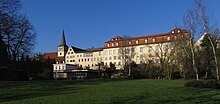Hohenlohe-Ingelfingen was a German County of the House of Hohenlohe, located in northeastern Baden-Württemberg, Germany, around Ingelfingen. Hohenlohe-Ingelfingen was a scion of Hohenlohe-Langenburg. It was raised from a County to a Principality in 1764, and was mediatised to Württemberg in 1806. [1]

Hohenlohe is the name of a German princely dynasty descended from the ancient Franconian Imperial immediate noble family that belonged to the German High Nobility. The family was granted the titles of Count and, later, Prince. In 1806 the Princes of Hohenlohe lost their independence and their lands formed part of the Kingdoms of Bavaria and of Württemberg by the Act of the Confederation of the Rhine. At the time of this mediatization in 1806, the area of Hohenlohe was 1 760 km² and its estimated population was 108,000. The Act of the Confederation of the Rhine deprived the Princes of Hohenlohe of their Imperial immediacy, but did not confiscate their possessions. Until the German Revolution of 1918–19 the Princes of Hohenlohe, as other mediatized families, had important political privileges. They were considered equal by birth (Ebenbürtigkeit) to the European Sovereign houses. In Bavaria, Prussia and Württemberg the Princes of Hohenlohe had hereditary right to sit in the House of Lords. In 1825 the Assembly / Diet of the German Confederation recognized the predicate of "Serene Highness" (Durchlaucht) for the heads of the Hohenlohe lines.

Baden-Württemberg is a state in southwest Germany, east of the Rhine, which forms the border with France. It is Germany’s third-largest state, with an area of 35,751 km2 (13,804 sq mi) and 11 million inhabitants. Baden-Württemberg is a parliamentary republic and partly sovereign, federated state which was formed in 1952 by a merger of the states of Württemberg-Baden, Baden and Württemberg-Hohenzollern. The largest city in Baden-Württemberg is the state capital of Stuttgart, followed by Karlsruhe and Mannheim. Other cities are Freiburg im Breisgau, Heidelberg, Heilbronn, Pforzheim, Reutlingen and Ulm.

Germany, officially the Federal Republic of Germany, is a country in Central and Western Europe, lying between the Baltic and North Seas to the north, and the Alps to the south. It borders Denmark to the north, Poland and the Czech Republic to the east, Austria and Switzerland to the south, France to the southwest, and Luxembourg, Belgium and the Netherlands to the west.
Contents
- Counts of Hohenlohe-Ingelfingen (1701–1764)
- Princes of Hohenlohe-Ingelfingen (1764–1806)
- Post-mediatization
- Notes
- References



